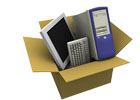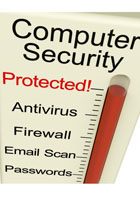

Why Do We Recommend Gmail?
There are a number of great seasons to recommend Google's Gmail as the best e-mail service on the planet! Gmail is not associated with any ISP (Internet Service Provider), and so your e-mail address remains the same even when you switch ISPs to get better service or a better bundled price. This feature is not unique to Gmail, but it is an important feature. Changing an e-mail address is a pain!
It has the great feature that you can use it in either of two modes, which are:
- Webmail: It can be used as a web based service, so you can reads and send e-mail from any computer that has a web browser and an Internet connection. This is great for when you travel, or at the library, etc. The web interface is fast and innovative. Other "webmail" services such as Microsoft's Hotmail and Yahoo also allow you to do this, but Gmail is the most responsive..
- IMAP4 PC Client: Gmail can also be used with a PC or MAC based POP3 or IMAP4 client, such as Thunderbird, Eudora, Outlook Express, and many others. This means you can compose new e-mails when not connected to the Internet, and you can download all of your e-mails in a burst, and read them later when you not connected to the Internet. This is particularly useful for laptop users. This is great for train/plane/bus travel! IMAP is a far superior protocol relative to POP3 and should be used if your PC client supports it. (Nearly all clients do support IMAP.)
Which method should I choose?
Method #2 may be foreign to many of our youth that think that Hotmail and other web-based services are the only way to do e-mail, but the PC based client for e-mail was one of the original ways Internet users accessed their e-mail, and it is still the best. Most people originally had access to the Internet using costly dial-up access where you paid for connect time by the hour. The ability to quickly send and receive all of your mail while you were connected, and then disconnect and read and respond to e-mails offline at your leisure was a more cost effective, and convenient way to use e-mail. The retrieving and sending of e-mail was done automatically in the background, to minimize the time you were connected to the Internet. These clients still work automatic with today's computers that are always connected to the Internet, the only difference is that they do not disconnect from the Internet when they are finished checking for mail. This is the way that most business users access e-mail today..
The 1st method has it conveniences, and is easiest to setup. It does have some down sides which are:
- It may have adverts that help to pay for the service.
- Any web based e-mail service has the risk that if you are typing in a long e-mail the internet connection can be broken, and you loose your work, and have to type it in again. ( One solution is to compose your message in Microsoft Word, saving it periodically and when finished copy and paste it into the compose box of your web based e-mail service.)
- The mail you send may have adverts (Hotmail) and there may be ads when you read your e-mail (but not with Gmail.)
One key reason I recommend Gmail is that you can use either or both of these methods. As a bonus Gmail is free! Hotmail, Yahoo and others do not give you as many choices.
Gmail's web interface is fast!
Gmail is also renowned for being the fastest program to use when you use the web interface, and they introduced a number off innovations that not other web based mail service was offering. (Look up AJAX) The other services are still playing catchup with Gmail's many great features.
Other good features
Gmail will also forward e-mail to another e-mail account, such as when you are away and you wish someone else to handle your e-mail for you.
Gmail also gives you a LOT of space, which other competitors are copying. They have a pretty good spam filters to block mail that you don't want to see. They also try to block any virus activity in the mail that uses their mail servers.
Gmail has a good address book that you can store more than simple e-mail addresses. You can store postal addresses and telephone numbers, and a good deal of additional information. If you use this, you can retrieve an Aunt's postal address or a friend's e-mail address from anywhere that you have access to the Internet, such as at a relative's house.
Why Use Gmail when Rogers or Bell offer me a free e-mail account?
Bell offers a re branded Hotmail, and Rogers offers a re branded Yahoo webmail products. These are good, but not as good and flexible as Gmail.- Gmail is a better service, period. This is my personal opinion.
- If you use a Bell (Sympatico) e-mail address and you get annoyed with Bell and want to switch to Rogers, or you live in a rural area and have a Bell dial-up service and suddenly you can get high speed Internet with Storm.ca, then you may switch Internet Service Providers (ISP). If you change ISPs and you had been using their free e-mail address, then you will loose your e-mail address at your old ISP and you will have to inform everyone you e-mail of the change. If you use a Gmail account, you can change ISPs and nothing changes with your e-mail address.
- If for instance you have a Rogers Internet account, and you are visiting a friend that has chosen Bell as their ISP, and you want to send an e-mail using your laptop and an e-mail client, you will find that Bell will not send out that e-mail. You will get an error message that states that they do not relay e-mail. Translated in English, the Bell SMTP server is saying I don't recognize you as a customer, and as an anti-spam measure I will not send out this e-mail for you. If you were using Gmail, this does not occur and you don't care who the ISP is when you send an e-mail. Your e-mail is sent out by Gmail's SMTP server, which knows who you are. The same "we do not relay" problem can happen at an Internet hotspot such as at Chapters or Starbucks or the Library or even where you work, but if you use a Gmail address you are fine.
My recommendations
For new e-mail users, I recommend starting out using Gmail and become familiar and comfortable with the web-based interface, and also with using an address book to store frequently used e-mail, postal addresses and telephone numbers.
Then after you are comfortable with this method, then use Thunderbird or Eudora or Outlook Express or another client on your PC to try out the PC based client method of accessing your e-mail. There are at least 28 free e-mail client programs available for the PC and a smaller number for the MAC. Learning to use a PC based client is particularly recommended if you have a laptop computer. Meanwhile all of your previous mail remains available on Gmail.
Use the IMAP protocol for the best experience. The older POP3 protocol can't handle synchronizing multiple clients that access the same mail account, but IMAP4 can.
Thunderbird is a free e-mail client that is open sourced and written by some of the same people that brought you the Firefox web browser. You can move your Gmail address book entries (export them) and read them into (import) your Thunderbird client's address book. Microsoft's Outlook (part of Microsoft Office) and Outlook Express (free, part of Windows) are probably together the most widely used PC based clients, and most often used by medium and large businesses.
Eventually you would use a combination of the two methods, using the Web browser to access Gmail when you are not using your own computer, and the PC client e-mail program when you are using your own computer.




